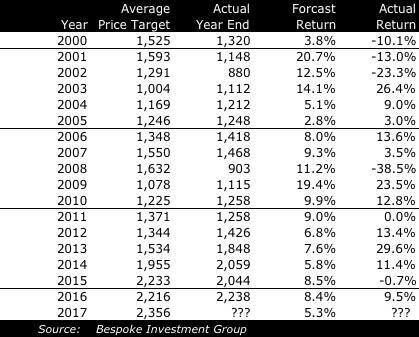It’s forecast time on Wall Street and despite the folly of it, individuals and professionals alike pay attention anyway.
On average, and according to Bespoke Investment Group, the 15 most prestigious analysts and strategists are calling for a measly five percent gain, which would put the S&P 500 at 2,356 at year end, compared to 2,234 from last week.
Collectively, that’s the lowest average forecast since 2005, when the strategists said that the S&P 500 would only gain 2.8 percent. As it happened, they were on target that year, and the price change for the index was 3.0 percent (they never forecast the dividends, just the price targets).
While the analysts got it right that year, they have as many misses as they have hits. Since the year 2000, as a group, the analysts thought that the S&P 500 would gain 9.6 percent, but the average actual change was 4.2 percent.
You might look at that and think that they are overly optimistic, but a lot of it has to do with chronically missing the bear markets. Back in 2008, for example, they said that the market should rise 11.1 percent, and went on to miss the biggest calendar decline since the Great Depression, a loss of -38.5 percent.
In 2000, 2001 and 2002, when the S&P 500 lost -10.1, -13.0 and -23.4 percent respectively, the strategists had said that the market would gain 3.8, 20.7 and 12.4 percent. Wow – that’s a cumulative loss of -40.1 percent compared to cumulative forecasts of 40.4 percent.
Despite the cockeyed optimism during those bear markets, the group has been dour since the 2008 global financial crisis. With the exception of 2009, when they did correctly call a strong market, they’ve said each year that the market would gain between five and 10 percent.
As it happens, not a single one of those years has been between five and 10 percent. In 2010, 2012, 2013, 2014 and 2016, the price gains were all in excess of 10 percent (and as high as 29.6 percent), while in 2011 and 2015, the market was dead even or modestly down.
Years ago, I did a tongue-in-cheek forecast of my own for Acropolis. I took the average return of about 10 percent and assumed that the market wouldn’t fall more than -30 percent or gain more than 40 percent, which is exactly what you would expect 95 percent of the time, assuming a normal distribution (it’s not normal, but this was a forecast, it doesn’t have to be right!).
When I told one of my clients that we had a forecast, he was so excited that I immediately regretted my little joke. When I told him the forecast, he immediately realized that it was too big of a range to be useful and was crestfallen that I didn’t have anything real for him.
Of course, when looking at the data above, I feel as though my forecast was far more real than those of the strategists.



